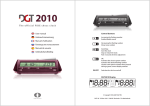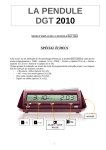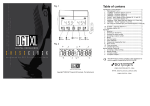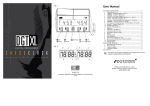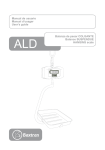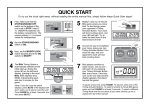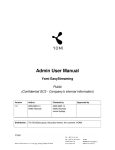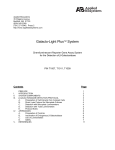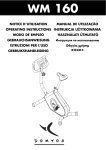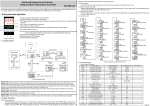Download DGT 2100 Manual - South Hams Chess Club
Transcript
2010 The official FIDE chess clock User manual Gebrauchsanweisung Manuel d’utilisation Руководство пользователя Manual de usuario Gebruikshandleiding Control buttons Increasing the flashing number Enable/disable sound Decreasing the flashing number Show move number Start/Stop Start the clock Stop or restart the clock Push 3 seconds for time adjustment OK: Activates the chosen option number Activates the desired flashing number Checks active option number when pressed during a game; correct display contrast ON/OFF Switches the clock on and off DGT2010 Display © Copyright 1994-2007 DGT BV DGT BV PO Box 1295 7500 BG Enschede The Netherlands Option Clock type 01 Time blitz Basic time / extra times 5 min 02 Time rapid 25 min 03 Time manual set 04 Time + guillotine 2 hrs f.b. 30 min 05 Time + guillotine manual set 06 2 x Time + guillotine 2 hrs f.b. 1 hr f.b. 30 min 07 2 x Time + guillotine manual set 08 Time + repeating 2nd period 2 hours f.b. 1 hour (repeating) 09 Time + repeating 2nd period manual set 10 Time + Bonus (“Fischer”) 25 min f.b. 5 min + 10 sec./move 11 Time + Bonus (“Fischer”) 2 hrs f.b. 15 min + 30 sec./move 12 Time + Bonus (“Fischer”) manual set 13 2 x Time + Bonus (“Fischer”) 2 hrs, f.b. 1 hr f.b. 15 min + 30 sec./move 14 2 x Time + Bonus (“Fischer”) manual set 15 Bonus (“Fischer”) blitz 3 min + 2 sec/move 16 Bonus (“Fischer”) rapid 25 min + 10 sec/move 17 Bonus (“Fischer”) slow 90 min + 30 sec/move 18 Bonus (“Fischer”) manual set 19 Bonus tournament 90 min f.b. 15 min (all + 30sec./move) 20 Bonus tournament 100 min f.b. 30 min (all + 30sec./move) 21 Bonus tournament 4 periods manual set (with / without move counter) 22 Delay (“Bronstein”) 5 min + 3 sec./move free 23 Delay (“Bronstein”) 25 min + 10 sec./move free 24 Delay (“Bronstein”) 1 hr 55 min 5 sec/move free 25 Delay (“Bronstein”) manual set 26 Go with byo-yomi 1 hr f.b. 1x20 sec. byo-yomi 27 Go with byo-yomi 2 hrs f.b. 1x30 sec. byo-yomi 28 Go with byo-yomi manual Set 29 Canadian byo-yomi 1 hr f.b. 5 min overtime 30 Canadian byo-yomi manual set 31 Hour Glass 1 min 32 Hour Glass manual set 33 Gong 10 sec. 34 Gong manual set 69 2010 The official FIDE chess clock 4 User manual 14 Gebrauchsanweisung 26 Manuel d’utilisation 38 Руководство по использованию 48 Manual de usuario 58 Gebruikshandleiding We spared no efforts to make sure that the information in this manual is correct and complete. However no liability is accepted for any errors or omissions. DGT reserves the right to change the specifications of the hardware and software described in this manual without prior notice. No part of this manual may be reproduced, transmitted or translated in any language in any form, by any means, without the prior written permission of DGT. ENGLISH Overview 5 Registration methods 5 Introduction 5 1. 2. 3. 4. 5. 5a. 5b. 5c. 5d. 6. 7. 8. 9. 10. 5 5 5 5 6 6 6 6 6 7 7 7 7 7 Time Rapid and Blitz (Options 1, 2 and 3) Time + Guillotine (Options 4 and 5) 2 x Time + Guillotine (Options 6 and 7) Time + Repeating Time (Options 8 and 9) Bonus (“Fischer”) options (Options 10-21) Time + Bonus (“Fischer”) (Options 10-12) 2 x Time + Bonus (“Fischer”) (Options 13-14) Bonus (“Fischer”) single period (Options 15-18) Bonus tournament (Options 19-21) Delay (“Bronstein”) (Options 20 to 25) Time + professional byo-yomi (Options 26, 27 and 28) Time + Canadian byo-yomi (“Overtime”) (options 29, 30) Hourglass (Options 31 and 32) Gong (Options 33 and 34) Operation 8 1. 2. 3. 4. 5. 6. 8 8 8 8 8 7. 8. 9. 10. 11. 12. 13. 14. 15. 16. 17. 18. 19. 20. 21. 22. Batteries. Batteries Switching the timer on Choosing an option number . Option number choice Activating the option number. Activating the option number Starting a game. Starting a game Temporarily stopping the timer. Temporarily stopping the timer Audible signal Time and move counter correction Manual settings and manual adjustment Skipping manual settings or time changes Display symbols. Display signals Time display112. Time display Checking the option number. Checking the option number during a game The move counter Checking the move number Fast setting using Auto repeat Reload Canadian Byo-yomi time Display contrast adjustment Detailing on time corrections Detailing on manual setting Care and cleaning Technical data List of option numbers 4 8 8 8 10 11 11 12 12 12 12 12 12 12 12 12 12 13 13 69 Overview This DGT2010 Game Timer has been designed to be used as game clock for various two-person board games, especially Chess, Go and Draughts. The main features are: • 13 different algorithms covering all popular timing standards • Manual programming of all these methods • 21 preprogrammed options for quick and ease of use • Move counter for all options • Time and move counter correction option during a game • Optional sound alert to warn for running out of time • LCD contrast correction feature • Low battery indication Registration methods Introduction Time forms a part of every sport, especially sports such as chess, go, draughts, shogi and scrabble®. The difference between the players is determined not only by the potential performance level of the individual player but also by the time the player needs in order to reach this level. The more a sport is seen as a measure of performance the more important it is to limit the time a player needs to make a move. This must be done in a way which is most appropriate for the game and the sport concerned. The DGT 2010 offers 13 different methods for registering the timing of a game between two players. Whilst several methods are well known, others may be less familiar. Several of these methods have been in use for a long time; others are the result of the possibilities offered by modern electronics. Every method has its own charm and has an influence on the manner in which a sport is experienced. The traditional “quickie” of 5 minutes per person is different from 3 minutes using “Delay” or “Bonus” in which every move attracts an extra 3 seconds of thinking time, although the total thinking time for a game is hardly any different. We recommend players to experiment with the various methods which the DGT 2010 offers. It can add an extra dimension to a favorite sport. 1. Time Rapid and Blitz (Options 1, 2 and 3) This is the simplest way to indicate time. Both players are receive one period of time in which they must make all moves. 2. Time + Guillotine (Options 4 and 5) The first period is used to play a predetermined number of moves. The second period, the Guillotine, is used to complete the game. 1 Period + Guillotine is similar to “Rapid and Blitz” but with a slower start. Notice that the guillotine time is added for both players when one player used all first period time (not after the completion of e.g. 40 moves). 3. 2 x Time + Guillotine (Options 6 and 7) For an even quieter start it is possible to play a game with two periods before the Guillotine. Notice that the second and guillotine time are added when one player passes zero time. 5 4. Time + Repeating Time (Options 8 and 9) A quiet end to a game also has its advantages. The simple traditional clock gives the players repeated one-hour periods in which to complete a subsequent number of moves. 5. Bonus (“Fischer”) options (Options 10-21) The Bonus method (or “Fischer”) is a timing system, where for each separate move to play, a bonus time is added to the available time. This method gives the players always the possibility to continue a game, even when much time was spent in earlier moves. It is possible to obtain increased thinking time by completing a move in a time which is shorter than the extra time allowed. The total time increases with the bonus time that is not used. Notice that the bonus time is already added for the first move. In all Bonus options: If a player has used the last period playing time, and no time is added anymore, the clock stops, and also the clock of the opponent blocks and can not set to count down anymore. End of the game! 5a. Time + Bonus (“Fischer”) (Options 10-12) When the first player reaches zero time in the first (Time) period, both players enter Bonus period, and receive the second period time. The bonus time is added at finishing each move. 5b. 2 x Time + Bonus (“Fischer”) (Options 13-14) When the first player reaches zero time in the second (Time) period, both players enter Bonus period, and receive the third period time. The bonus time is added at finishing each move. 5c. Bonus (“Fischer”) single period (Options 15-18) Single period Fischer method. The clock starts with the bonus time for the first move added already. 5d. Bonus tournament (Options 19-21) The Bonus tournament method is the most complex in the way thinking time is regulated. It features up to 4 periods of main time, during all, the bonus time is added for each move. In the preset options 19 and 20, each with two time periods, the second period starts when one player used all the first period time, and passes zero. Both players receive the second period Basic time added on that moment. The option 21 (Bonus tournament 4 periods) allows the programming of 4 periods, with different basic time, all with the same bonus time per move. For the periods 1 to 3, a move number can be programmed. If the move number is set to a non-zero number, the next period time is added when a player finished the programmed number of moves for that period. If the move number is programmed to the value 0 (zero), the transient to the next period takes place when a player passes zero time. If a player does not finish the programmed (non-zero) number of moves for a period, at passing zero time, the blinking flag is shown, and the DGT 2010 stops time counting for both players, indicating that the game has ended. That player lost the game! 6 For the correct working of the move counter driven Bonus Tournament option, the players are obliged to correctly stop the clock after each finished move, so that the clock keeps track of the played number of moves Always ensure that the lever is in the correct position and the player color icons are correct before a game begins. 6. Delay (“Bronstein”) (Options 22 to 25) The oldest proposal from the chess world for a solution to the problem of limited thinking time came from IGM David Bronstein. His method applies from the first move. Before this main thinking time starts counting down the player has a fixed amount of time to complete a move. It is not possible to increase the thinking time by playing more quickly as it is in the Bonus methods. The delay time is initially added to the Basic time. The clock always shows the total available time, that is the main time plus the delay time per move (or, on a running clock, the remainder of the main time plus the remainder of the delay time, if any) 7. Time + professional byo-yomi (Options 26, 27 and 28) From its very nature the game of Go lends itself naturally to allowing players extra time to complete a game. Traditionally, the byo-yomi method is used for this. Byo-yomi gives the player who has used up his thinking time a fixed amount of time for each subsequent move. In normal games of Go the principal thinking time allowed is 1 1/2 to 2 hours, usually combined with a byo-yomi of 20 to 30 seconds. After the principal thinking time has been used the clock jumps to byo-yomi time. Each time a player completes a move the clock jumps back. If the player has not completed the move before the clock reaches 0 a flag appears in the display. For top matches the principal thinking time can be 9 hours which is followed by 5 byo-yomi periods of 1 minute each. At the end of the 9-hour period the clock jumps to 5 minutes. If the player completes a move before a time of 4 minutes is reached the clock jumps back to 5 minutes. If he completes a move after the 4-minute period has been exceeded, the clock reverts to 4 minutes. The clock thus reverts each time to the beginning of the current byo-yomi period. Note that the icon “byo-yomi” is shown in the display as soon as a player enters the byo-yomi phase. The flag sign is not shown yet, the flag sign is shown when a player reached zero, during byo-yomi. The game can go on, the flag is cleared when the players next turn starts. 8. Time + Canadian byo-yomi (“Overtime”) (options 29, 30) Canadian byo-yomi offers a simplified version of professional byo-yomi. It gives a player the extra time to complete a number (5 to 25) of moves instead of extra time per move. After passing the first period (TIME), the byoyomi time is given, and the byo-yomi icon is shown in the display. When the agreed number of moves is made, the players clock can be reloaded with the byo-yomi time by pressing the “-“ button for 1 second. 7 9. Hourglass (Options 31 and 32) A player’s thinking time is gradually reduced whilst at the same time that of his opponent is increased. This way of playing is an exciting alternative to the traditional “quickie”. The clock stops when a player reaches zero, thus losing the game. 10. Gong (Options 33 and 34) Before the introduction of clocks with double timers, tournaments were often controlled with a gong. The gong was used to mark a fixed time for each move. Option 33 provides a fixed time of ten seconds alternately for first the left-hand player followed by the same amount of time for the righthand player, and so on. Operation 1. Batteries The DGT 2010 requires 2 AA (penlight) batteries. We recommend low selfdischarge alkaline batteries, on which it will run for 10 years, theoretically. If you do not plan to use your timer for a long period, we recommend that you remove the batteries to avoid damage caused by leaking. If the Low Battery symbol *** appears on the timer display, the batteries need replacement. When this message first appears, the batteries still contain enough energy to allow the current game to be completed. In case of a malfunction, first remove then reinsert the batteries. 2. Switching the timer on Switch the timer on and off with the On/Off button on the bottom of the timer. The on/off button is placed on the bottom to avoid unintended reseeting of the clock. 3. Choosing an option number When you switch on the timer, the display shows the option number that or button to step through the 34 optiwas last selected. Press the ons. After number 34, the display returns to 01. To find the option you wish, see the list of option numbers on the bottom of the timer (For example, option 02 corresponds to Time Rapid: 25 minutes). 4. Activating the option number When the option number you want appears on the display, activate it by pressing the OK button. The display then shows the default starting time for that option. You can now begin your game. If you selected a manual set option, refer to Section 9, Manual settings. 5. Starting a game When you have selected an option with preprogrammed setting, check that the lever is upward for the white player. The player color is indicated with the KING symbol. Now start the timer by pressing the Start/Stop button. The correct setting of player color is important to keep good record of the move number, especially for the Bonus Tournament options 8 6. Temporarily stopping the timer During the course of a game, you can temporarily stop the timer by shortly pressing the Start/stop button. Restart the timer by pressing the start/stop button again (pressing longer than 2 seconds starts the time correction, explained in section 8). 7. Audible signal The DGT 2010 can give audible signals when a time control comes close. It beeps 10 seconds before every time control and also on all last 5 seconds. On the last second before time control a full second beep is given. The sound is given only when the “sound on” icon is visible on the display. The button while sound function can be switched on or off by pressing the the clock is stopped. The options 01 to 25 have the sound off by default, the options 26 to 34 have the sound on by default. 8. Time and move counter correction During a game, you can change the time that is currently displayed. Hold the start/stop button for two seconds, until the most left display digit starts blinking. Now the times of both players can be corrected, digit by digit. To or button. change the blinking digit, press the Press the OK button to step to the next digit. After the player’s time, the or move counter can be corrected: increase or decrease by pressing the button. When the value is correct, press OK. Now press Start/stop to restart the timer to resume the countdown based on the corrected times. See section 9. Detailing on time correction for specific aspects of some options. 9. Manual settings Each timing method has an option number to allow manual set of all the method parameters. After selecting a manual set option number (i.e. option 05 for Time + Guillotine) the parameters for this method must be set, figure by figure. First the main time for each players must be set. After this, a number of parameters follow, dependent on the selected option. See the below table for manual set parameters for all manual set options. or button. When the Change the currently blinking digit with the desired digit appears, press OK. This causes the next digit to start flashing. If you don’t want to change a digit, just press OK. When you have finished entering all the parameters, the display will show the Pause symbol > || and both players’ clock times. Now the clock can be started: refer to Operation paragraph 5 for further instructions. 9 Parameters that need to be programmed for manual set options: Option Name Display Settings 3 Time Rapid/Blitz Left-hand and right-hand player time 5 Time + Guillotine 2 First period left-hand and right-hand time Guillotine period time for both players 2 3 First period left-hand and right-hand time Second period for both players ** Guillotine period time for both players 2 First period left-hand and right-hand time Repeat period time for both players 7 2 x Time + Guillotine 9 Time + Repeating Time 12 14 Time + Bonus (“Fischer”) 2 x Time + Bonus (“Fischer”) 2 2 2 3 3 First period left-hand and right-hand time 2nd period time for both players 2nd period move bonus time for both players First period left-hand and right-hand time Second period for both players * 3rd period time for both players 3rd period move bonus time for both players 18 Bonus (“Fischer”) Left-hand and right-hand player time Move bonus time for left-hand player Move bonus time for right-hand player 21 Bonus Tournament (“Fischer”) (max. 4 periods) 1st period left-hand and right-hand time move bonus time for both players, all periods Number of moves in the 1st period * 2nd period time for both players * Number of moves in the 2nd period * Third period time for both players * Number of moves in the 3rd period * Fourth period time for both players * 2 2 3 3 4 25 Delay ( “Bronstein”) Left-hand and right-hand player time Free time for left-hand player Free time per move for right-hand player 28 Time + professional byo-yomi 1st period left-hand and right-hand time Byo-yomi time per move for both players Number of byo-yomi periods 30 Time + Canadian byo-yomi 1st period left-hand and right-hand time Canadian byo-yomi time 32 Hourglass Left-hand and right-hand player time 34 Gong Gong period time Parameter format: Left-hand and right-hand player time, Guillotine time, period time, repeating period time, Canadian Byo-yomi time, Gong period time: 10 H:MM followed by .SS: Hour units, minutes and then seconds (up to 9 hours, 59 minutes, 59 seconds) Bonus time: M.SS minutes and seconds (up to 9 minutes, 59 seconds) Number of moves for a period: NN 2 digit number up to 99 moves Free time for a player: M.SS Minutes and seconds (up to 9 minutes, 59 seconds) Number of Byo-yomi periods: N Single digit number from 1 to 9 10. Skipping manual settings or time changes When manual set or time correction is chosen, it is possible to skip the number-by-number entry of the values by pressing the Start/Stop button when the first digit is flashing. The parameters stay unchanged and the clock will show > || and is ready to be started. 11. Display symbols In addition to the digits, the timer’s display shows the following symbols: Symbol Meaning Indicates that the batteries must be changed Indicates that a Bonus period is active Indicates that a Delay period is active byo-yomiindicates that a Byo-Yomi period is active This can be a Professional Byo-Yomi or a Canadian Byo-Yomi The interim flag; indicates that this player has first gone to the next time period. Disappears after 5 minutes. The (flashing) ultimate flag; indicates a player who has run out of time. Indicates that the times displayed are in hours and minutes. A colon separates the hour and minutes digits (for instance 1:45 or 0:25). Indicates that the times displayed are in minutes and seconds. A dot separates the minutes and seconds digits (for instance 17.55 or 4.06). Indicates that the sound function is active, and the clock will beep when approaching zero time. Indicates that the clock is paused, either ready for the first start, or paused by pressing Start/Stop, or halted due to a player reaching a time limit. Indicates that the clock is running. / Indicates the player color. 11 12. Time display For times over 20 minutes, the DGT 2010 displays hours and minutes. The icons hrs and min are visible. For times under 20 minutes, the clock displays minutes and seconds and the icons min and sec are visible. The maximum displayable time is 9:59.59. If a time would exceed this, it is clipped to 9:59.59 without warning. 13. Checking the option number During a game, you can check the selected option number without interrupting the countdown. To do this, press the OK button. 14. The move counter The clock keeps track of the number of moves that have been completed. When starting a new game, the move counter has the value 0. The move counter is incremented when the black player (see the / icons on the display) ends the turn. 15. Checking the move number When the clock is running or paused, you can see the move number by presbutton. The running clock is not interrupted by this action. sing the 16. Fast setting using Auto repeat For fast operation, you can hold the they will repeat. , or OK buttons. After a second, 17. Reload Canadian Byo-yomi time During Byo-yomi in options 29 and 30, the byo-yomi time for the player on turn can be reloaded by holding the “–“ button down for 1 second. 18. Display contrast adjustment If necessary, the contrast of the display can be adjusted in 16 steps. The clock must be in pause mode (showing > ||). Now press and hold the OK button. The option number will be shown. Keep the OK button pressed, button repeatedly to darken the display or press the and press the button repeatedly to make the display lighter. Release the OK button when done. The contrast setting is kept until the batteries are removed. 19. Detailing on time corrections If you make a time correction during an option with more time periods, normally, the clock will assume that the same period is active as when time correction started. So when for example during option 10, in period 2 (Bonus), the time is corrected to 1 hour, the bonus method will stay active. Option 21: Bonus tournament however, offers the possibility to allot a number of moves for each period. If the move numbers for each period are programmed to a non-zero number, then during time correction, the move number can be changed and the correct period is calculated from that. 20. Detailing on manual setting If after a manual set option, the game is ended and the same manual set option is selected again, without a different option played in between, the parameters from the first setting are conserved. See par. 10 for a quick way to start the new game. 12 No period change. If in a multiple period setting, an intermediate period is programmed with zero period time, this period is skipped during the game and the next period becomes active. The manual set option 21: Bonus tournament is the most advanced option. Notice that when the move number for a period is programmed zero, the period will end when a player runs through zero time. When for a period, zero moves are programmed, and then the eventual trailing periods will automatically be set to zero moves. These trailing period move numbers can not be set to non-zero value. 21. Care and cleaning Your DGT 2010 is a durable, well-made product. If you treat it with reasonable care, it should give you years of trouble-free performance. To clean the clock, use only a slightly-moistened soft cloth. Do not use abrasive cleansers. 22. Technical data Batteries: Two AA-size (alkaline recommended; current consumption 2 uA when off, 10 uA when on (battery life approx. 10 yrs.) Accuracy: Within 1 second per hour Housing: ABS plastic The DGT 2010 complies with EN 50081-1:1991 and EN50082-1:1991 regulations. The product complies with the RoHS directive EU/2002/95/EC 13














